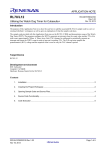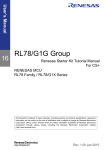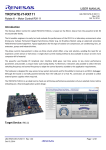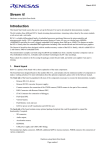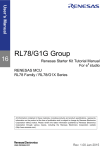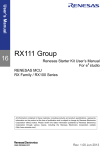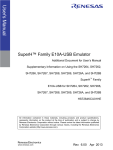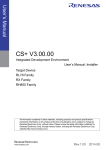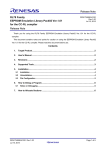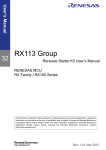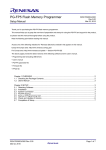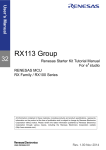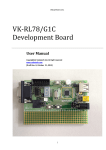Download RL78/G1C Utilising I²C in Slave Mode for Cubesuite+
Transcript
APPLICATION NOTE RL78/G1C Utilising I²C in Slave Mode for Cubesuite+ R01AN1737EG0100 Rev.1.00 Nov 11, 2013 Introduction The purpose of this Application Note is to show the user how to add the associated RL78/G1C sample code to a new or existing CubeSuite+ workspace; as well as give an explanation of what the sample code does. The sample code provided with this Application Note demonstrates usage of the I2C Interface in Slave Mode. The program runs on the RL78/G1C RSK and demonstrates usage by simulating an EEPROM memory device, similar to the Renesas R1EX24xxx series. Target Device RL78/G1C Development environment IDE: Cubesuite+ Compiler: CA78K0R Hardware: Renesas Starter Kit for RL78/G1C Contents 1. Installation ......................................................................................................................................... 2 2. Creating the Project Workspace ....................................................................................................... 2 3. Opening Sample Code and Source Files .......................................................................................... 4 4. Source Code Functionality ................................................................................................................ 4 5. Code Execution ................................................................................................................................. 5 R01AN1737EG0100 Rev.1.00 Nov 11, 2013 Page 1 of 6 RL78/G1C 1. Utilising I²C in Slave Mode for Cubesuite+ Installation This section assumes CubeSuite+ IDE is already installed on the user’s personal computer (PC). Create a new folder and name it as ‘RSKRL78G1C_Workspace’. Copy the zipped file an_r01an1737eg0100_rl78g1c_iic.zip’, available in the Application Note package downloaded from the website, to this folder. Extract the IIC_Slave.zip file to the RSKRL78G1C_Workspace folder. 2. Creating the Project Workspace Open CubeSuite+ IDE by clicking the Windows Start button, select All Programs > Renesas Electronics CubeSuite+ > CubeSuite+. R01AN1737EG0100 Rev.1.00 Nov 11, 2013 Page 2 of 6 RL78/G1C Utilising I²C in Slave Mode for Cubesuite+ From the menu bar select File > Project > Open Project… CubeSuite+ will open a dialog. Navigate to the unzipped IIC_Slave folder located in RSKRL78G1C_Workspace. Select the IIC_Slave.mtpj file. Click <Open> A Progress Status dialog will appear briefly whilst CubeSuite+ loads the project. R01AN1737EG0100 Rev.1.00 Nov 11, 2013 Page 3 of 6 RL78/G1C 3. Utilising I²C in Slave Mode for Cubesuite+ Opening Sample Code and Source Files Once the project has been opened, the source code and all dependant files can be opened in the editor by expanding the folders in the Project Tree window and double clicking the files listed. All files have been grouped according to their file type. 4. Source Code Functionality The source code project is specifically written to run on the appropriate RSK. However this source code can be useful as an example even without the RSK. The project was written using source files containing API functions generated using Code Generator. The project will contain a C source file ‘r_cg_main.c’. This source file includes the C function main(). All source files and dependant files whose filenames are prefixed with ‘r_’ were generated using Application Leading Tool. R01AN1737EG0100 Rev.1.00 Nov 11, 2013 Page 4 of 6 RL78/G1C 5. Utilising I²C in Slave Mode for Cubesuite+ Code Execution Demonstrates usage of the IIC interface in slave mode, by simulating an EEPROM memory device similar to the Renesas R1EX24xxx series. The memory capacity is 8 bytes. The IIC interface is configured to respond when addressed with the slave device address 0xA0. Modifications: The IIC pull-up resistors are connected to Board_VDD by default. This is correct for power configurations where Board_VDD is 5V. For power configurations where Board_VDD is 3.3V, the IIC pull-up resistors should be connected to Board_5V, by removing R83 and fitting R84. Please refer to the schematics document and component placement diagram in the User Manual to help locate components. Instructions: 1. Connect a compatible EEPROM memory device as follows: EEPROM | RSK SDA -> SDA (JA1, pin 25) SCL -> SCL (JA1, pin 26) GND -> Any ground point. (Ensure the device is powered as its datasheet specifies) 2. Build and download the sample code to the RSK. 3 Open the 'Watch' window from the menu bar: View > Watch > Watch 1 Add the 'g_master_data' global variable to the 'Watch 1' window by right-clicking on the variable and selecting Register to Watch 1'. The variable will act as the simulated EEPROM memory. 4. Click 'Go' to start the program execution. "IIC S" will be displayed on the debug LCD. 5. When a valid read request is sent from a master device, the RSK will respond correctly and display "RD" on the debug LCD. 6. When a valid write request is sent from a master device, the RSK will store the write data into the simulated EEPROM memory, and display "WR" on the debug LCD. 7. If the RSK displays "ERR", it means the program has detected a failed IIC transmission. Reset both the master slave devices and retry. R01AN1737EG0100 Rev.1.00 Nov 11, 2013 Page 5 of 6 RL78/G1C Utilising I²C in Slave Mode for Cubesuite+ Website and Support Renesas Electronics Website http://www.renesas.com/ Inquiries http://www.renesas.com/contact/ All trademarks and registered trademarks are the property of their respective owners. R01AN1737EG0100 Rev.1.00 Nov 11, 2013 Page 6 of 6 Revision History Description Rev. Date Page Summary 1.00 Nov 11, 2013 — First edition issued A-1 General Precautions in the Handling of MPU/MCU Products The following usage notes are applicable to all MPU/MCU products from Renesas. For detailed usage notes on the products covered by this document, refer to the relevant sections of the document as well as any technical updates that have been issued for the products. 1. Handling of Unused Pins Handle unused pins in accord with the directions given under Handling of Unused Pins in the manual. ⎯ The input pins of CMOS products are generally in the high-impedance state. In operation with an unused pin in the open-circuit state, extra electromagnetic noise is induced in the vicinity of LSI, an associated shoot-through current flows internally, and malfunctions occur due to the false recognition of the pin state as an input signal become possible. Unused pins should be handled as described under Handling of Unused Pins in the manual. 2. Processing at Power-on The state of the product is undefined at the moment when power is supplied. ⎯ The states of internal circuits in the LSI are indeterminate and the states of register settings and pins are undefined at the moment when power is supplied. In a finished product where the reset signal is applied to the external reset pin, the states of pins are not guaranteed from the moment when power is supplied until the reset process is completed. In a similar way, the states of pins in a product that is reset by an on-chip power-on reset function are not guaranteed from the moment when power is supplied until the power reaches the level at which resetting has been specified. 3. Prohibition of Access to Reserved Addresses Access to reserved addresses is prohibited. ⎯ The reserved addresses are provided for the possible future expansion of functions. Do not access these addresses; the correct operation of LSI is not guaranteed if they are accessed. 4. Clock Signals After applying a reset, only release the reset line after the operating clock signal has become stable. When switching the clock signal during program execution, wait until the target clock signal has stabilized. ⎯ When the clock signal is generated with an external resonator (or from an external oscillator) during a reset, ensure that the reset line is only released after full stabilization of the clock signal. Moreover, when switching to a clock signal produced with an external resonator (or by an external oscillator) while program execution is in progress, wait until the target clock signal is stable. 5. Differences between Products Before changing from one product to another, i.e. to a product with a different part number, confirm that the change will not lead to problems. ⎯ The characteristics of an MPU or MCU in the same group but having a different part number may differ in terms of the internal memory capacity, layout pattern, and other factors, which can affect the ranges of electrical characteristics, such as characteristic values, operating margins, immunity to noise, and amount of radiated noise. When changing to a product with a different part number, implement a system-evaluation test for the given product. Notice 1. Descriptions of circuits, software and other related information in this document are provided only to illustrate the operation of semiconductor products and application examples. You are fully responsible for the incorporation of these circuits, software, and information in the design of your equipment. Renesas Electronics assumes no responsibility for any losses incurred by you or third parties arising from the use of these circuits, software, or information. 2. Renesas Electronics has used reasonable care in preparing the information included in this document, but Renesas Electronics does not warrant that such information is error free. Renesas Electronics 3. Renesas Electronics does not assume any liability for infringement of patents, copyrights, or other intellectual property rights of third parties by or arising from the use of Renesas Electronics products or assumes no liability whatsoever for any damages incurred by you resulting from errors in or omissions from the information included herein. technical information described in this document. No license, express, implied or otherwise, is granted hereby under any patents, copyrights or other intellectual property rights of Renesas Electronics or others. 4. You should not alter, modify, copy, or otherwise misappropriate any Renesas Electronics product, whether in whole or in part. Renesas Electronics assumes no responsibility for any losses incurred by you or 5. Renesas Electronics products are classified according to the following two quality grades: "Standard" and "High Quality". The recommended applications for each Renesas Electronics product depends on third parties arising from such alteration, modification, copy or otherwise misappropriation of Renesas Electronics product. the product's quality grade, as indicated below. "Standard": Computers; office equipment; communications equipment; test and measurement equipment; audio and visual equipment; home electronic appliances; machine tools; personal electronic equipment; and industrial robots etc. "High Quality": Transportation equipment (automobiles, trains, ships, etc.); traffic control systems; anti-disaster systems; anti-crime systems; and safety equipment etc. Renesas Electronics products are neither intended nor authorized for use in products or systems that may pose a direct threat to human life or bodily injury (artificial life support devices or systems, surgical implantations etc.), or may cause serious property damages (nuclear reactor control systems, military equipment etc.). You must check the quality grade of each Renesas Electronics product before using it in a particular application. You may not use any Renesas Electronics product for any application for which it is not intended. Renesas Electronics shall not be in any way liable for any damages or losses incurred by you or third parties arising from the use of any Renesas Electronics product for which the product is not intended by Renesas Electronics. 6. You should use the Renesas Electronics products described in this document within the range specified by Renesas Electronics, especially with respect to the maximum rating, operating supply voltage range, movement power voltage range, heat radiation characteristics, installation and other product characteristics. Renesas Electronics shall have no liability for malfunctions or damages arising out of the use of Renesas Electronics products beyond such specified ranges. 7. Although Renesas Electronics endeavors to improve the quality and reliability of its products, semiconductor products have specific characteristics such as the occurrence of failure at a certain rate and malfunctions under certain use conditions. Further, Renesas Electronics products are not subject to radiation resistance design. Please be sure to implement safety measures to guard them against the possibility of physical injury, and injury or damage caused by fire in the event of the failure of a Renesas Electronics product, such as safety design for hardware and software including but not limited to redundancy, fire control and malfunction prevention, appropriate treatment for aging degradation or any other appropriate measures. Because the evaluation of microcomputer software alone is very difficult, please evaluate the safety of the final products or systems manufactured by you. 8. Please contact a Renesas Electronics sales office for details as to environmental matters such as the environmental compatibility of each Renesas Electronics product. Please use Renesas Electronics products in compliance with all applicable laws and regulations that regulate the inclusion or use of controlled substances, including without limitation, the EU RoHS Directive. Renesas Electronics assumes no liability for damages or losses occurring as a result of your noncompliance with applicable laws and regulations. 9. Renesas Electronics products and technology may not be used for or incorporated into any products or systems whose manufacture, use, or sale is prohibited under any applicable domestic or foreign laws or regulations. You should not use Renesas Electronics products or technology described in this document for any purpose relating to military applications or use by the military, including but not limited to the development of weapons of mass destruction. When exporting the Renesas Electronics products or technology described in this document, you should comply with the applicable export control laws and regulations and follow the procedures required by such laws and regulations. 10. It is the responsibility of the buyer or distributor of Renesas Electronics products, who distributes, disposes of, or otherwise places the product with a third party, to notify such third party in advance of the contents and conditions set forth in this document, Renesas Electronics assumes no responsibility for any losses incurred by you or third parties as a result of unauthorized use of Renesas Electronics products. 11. This document may not be reproduced or duplicated in any form, in whole or in part, without prior written consent of Renesas Electronics. 12. Please contact a Renesas Electronics sales office if you have any questions regarding the information contained in this document or Renesas Electronics products, or if you have any other inquiries. (Note 1) "Renesas Electronics" as used in this document means Renesas Electronics Corporation and also includes its majority-owned subsidiaries. (Note 2) "Renesas Electronics product(s)" means any product developed or manufactured by or for Renesas Electronics. http://www.renesas.com SALES OFFICES Refer to "http://www.renesas.com/" for the latest and detailed information. California Eastern Laboratories, Inc. 4590 Patrick Henry Drive, Santa Clara, California 95054, U.S.A. Tel: +1-408-919-2500, Fax: +1-408-988-0279 Renesas Electronics Europe Limited Dukes Meadow, Millboard Road, Bourne End, Buckinghamshire, SL8 5FH, U.K Tel: +44-1628-651-700, Fax: +44-1628-651-804 Renesas Electronics Europe GmbH Arcadiastrasse 10, 40472 D üsseldorf, Germany Tel: +49-211-65030, Fax: +49-211-6503-1327 Renesas Electronics (China) Co., Ltd. 7th Floor, Quantum Plaza, No.27 ZhiChunLu Haidian District, Beijing 100083, P.R.China Tel: +86-10-8235-1155, Fax: +86-10-8235-7679 Renesas Electronics (Shanghai) Co., Ltd. Unit 301, Tower A, Central Towers, 555 LanGao Rd., Putuo District, Shanghai, China Tel: +86-21-2226-0888, Fax: +86-21-2226-0999 Renesas Electronics Hong Kong Limited Unit 1601-1613, 16/F., Tower 2, Grand Century Place, 193 Prince Edward Road West, Mongkok, Kowloon, Hong Kong Tel: +852-2886-9318, Fax: +852 2886-9022/9044 Renesas Electronics Taiwan Co., Ltd. 13F, No. 363, Fu Shing North Road, Taipei, Taiwan Tel: +886-2-8175-9600, Fax: +886 2-8175-9670 Renesas Electronics Singapore Pte. Ltd. 80 Bendemeer Road, Unit #06-02 Hyflux Innovation Centre Singapore 339949 Tel: +65-6213-0200, Fax: +65-6213-0300 Renesas Electronics Malaysia Sdn.Bhd. Unit 906, Block B, Menara Amcorp, Amcorp Trade Centre, No. 18, Jln Persiaran Barat, 46050 Petaling Jaya, Selangor Darul Ehsan, Malaysia Tel: +60-3-7955-9390, Fax: +60-3-7955-9510 Renesas Electronics Korea Co., Ltd. 12F., 234 Teheran-ro, Gangnam-Gu, Seoul, 135-080, Korea Tel: +82-2-558-3737, Fax: +82-2-558-5141 © 2013 Renesas Electronics Corporation. All rights reserved. Colophon 3.0









